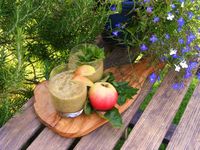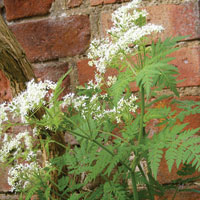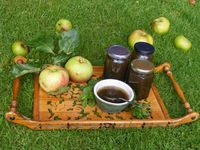Herbs and Apples
Many of the herbs which we use, like mints, sages, thymes and marjorams, originated in the Middle East and from around the Mediterranean. The first documented accounts of their use are as long ago as 2000 BC, but man has been using these decorative and useful plants for much longer than this.
In autumn there are still lots of herbs to harvest and use, and they combine really well with the fruit and vegetables which are in abundance at this time of year - tomatoes, courgettes, squash and, of course, apples. When you combine all the varieties of herb with the versatility of a fruit like the apple the combinations of the two are endless.
Apples have innumerable uses - in cooking, as drinks such as cider and juice and eating straight from the tree. Adding herbs will enhance and enliven the taste of apples in your cooking.
Apples make marvellous drinks such as cider, juice and punch. Try adding the leaves and/or flowers from one or more of the following sweeter herbs to make them attractive, interesting and deliciously refreshing: Lemon balm, Salad burnet, Lemon verbena, Mint especially Peppermint, Rosemary and French tarragon.
Mint, ginger and apple smoothie

Apples make a great breakfast smoothie, the addition of ginger
and mint will really give you a
boost, making a refreshing start
to the day.
Enough for 2
- 4 sweet juicy eating apples
- 150 ml apple juice
- 3 cm ginger root
- 8 sprigs of garden mint or 'Berries & Cream’'
- 2 tbs lime juice
Core the apples and chop coarsely, no need to peel,
red skinned
apples leave pretty red flecks in your smoothie.
Put half of the applesinto the blender or smoothie maker and whizz until smooth.
You may need a little extra apple juice, it depends on how juicy your apples are.
Add the peeled sliced ginger, mint and lime juice and blend again.
Finally add the remaining apple pieces and whizz until smooth.
Serve garnished with a sprig of mint or some apple slices

For an apple dessert the sweeter herbs are most useful, lemon balm is a favourite giving a lovely refreshing, lemony flavour and the yellow leaves of lemon balm make a pretty garnish. As balm is only a spring and summer herb then use lemon verbena sparingly in winter in the same way, see our information on lemon verbena for ways to preserve the foliage for winter use or pot up and bring indoor for a decorative and culinary house plant.
Mints also enhance the flavour of apples, try pineapple, peppermint or 'Berries and Cream'. More unusually sweet cicely with apples makes an interesting combination.
Don't forget the savoury uses, in soups, pies, casseroles and bakes the addition of apples with a complimenting herb such as rosemary, sage, winter savory, thyme or one of the oreganos will make a meal with a difference. As well as with meat dishes such as pork and chicken, apples and herbs pair well with root vegetables, eggs and all sorts of grains.
Herb vinegars are very popular and versatile, giving a lovely flavour to salads and sauces. To make your own - choose a cider vinegar with a good appley flavour and add sprigs of your chosen herb, picked in summer just before flowering when the essential oil content is at it’s peak. The best herbs to use are those with strong scents and flavours such as mints, tarragon, basil, oregano and lemon thyme.
Apples are also extensively used in preserves, both in jam and jelly making, where their high pectin content aids setting, and in chutneys where their cooked texture makes a good medium for the other ingredients. The addition of herbs will enhance the flavours. Try the sweeter herbs described above in jams and jellies, experiment with the more savoury based herbs in your pickles and chutneys.
Mint and Apple Jelly

Apples and mint are a delicious combination.
Mint and apple jelly
is both sweet and savoury and goes especially well with lamb
and also with roast pork and chicken.
Mint does lose its colour
with prolonged cooking,
you may if you wish add a few drops
of green food colouring before bottling, either way it is still delicious.
Makes 2 –3 jars
- 1 kg cooking apples
- 1 litre of water
- 6 sprigs of mint
- 50 g mint leaves — we like garden mint but do experiment
- 800 g sugar or maybe a little more
Coarsely chop the apples and put into a large pan with the sprigs of mint and 750 ml of the water.
Cook gently over a low heat until the apples are soft and fluffy. Leave to cool for 30 minutes.
Tip the apple pulp into a muslin bag and suspend over a bowl to drip.
You can use a fine sieve
if you don’t have a bag.
Leave as long as possible — overnight is best for maximum juice extraction -
gently move
the bag from side to side to speed up the juice dripping
but try not to squeeze as this makes
the jelly very cloudy.
Once the pulp in the bag is quite dry, put the remaining 250 ml of water in a pan and
add the 50 g of mint — finely chopped. Bring to the boil and then remove from the heat immediately.
Pour the mint and its water into a measuring jug and add the apple juice.
For each 100 ml of liquid
you will need 80 g of sugar, so for 1 litre you will need 800 g.
Put the minty apple juice into a large pan with the appropriate amount of sugar
and boil
on a medium heat until it reaches setting point, this will take about 40 minutes.
Keep a chilled saucer in the fridge and check periodically by putting a teaspoonful of the jelly
onto the cold saucer to see if it thickens and forms skin.
Pour into warmed sterilised jars.